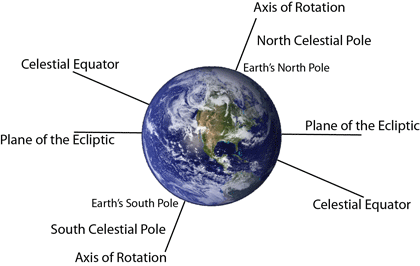| The
Earth's tilt (23.45º) causes the equatorial rotation
of the Celestial Sphere. As a result, those of us in
the
northern hemisphere can see some of the
constellations of the
southern hemisphere, and visa
versa. This sphere rotates about a virtual axis
called the North and South Poles.

For the
Northern Hemisphere, the axis of rotation
is centered in Polaris, a star in the constellation Ursa Minor (or Little Bear) - sometimes called the
Little Dipper. Polaris is not exactly at the axis of
rotation, but its pretty close. The pole star is
circled:
The
southern hemisphere is not so lucky. This image
has the south pole area circled, but there is no
star associated with this region:
The motion of this virtual sphere is the reason
for the changing positions of the
night sky. In
fact, the sky changes on a daily basis - with the
exception of the poles. Because the
Earth rotates
and orbits the
Sun at the same time, the
constellations rise 15 minutes earlier every night.
If one were to stand at the north pole, the same
constellations would be visible every night,
although rotated (counter-clockwise). All of the
constellations that lie below
Earth's equator would
never be visible. Likewise, standing at the south
pole would make the
northern constellations non
visible - but the stars would rotate clockwise!
Back to Top | Image Credit:
Starry Night v. 4.5
|

